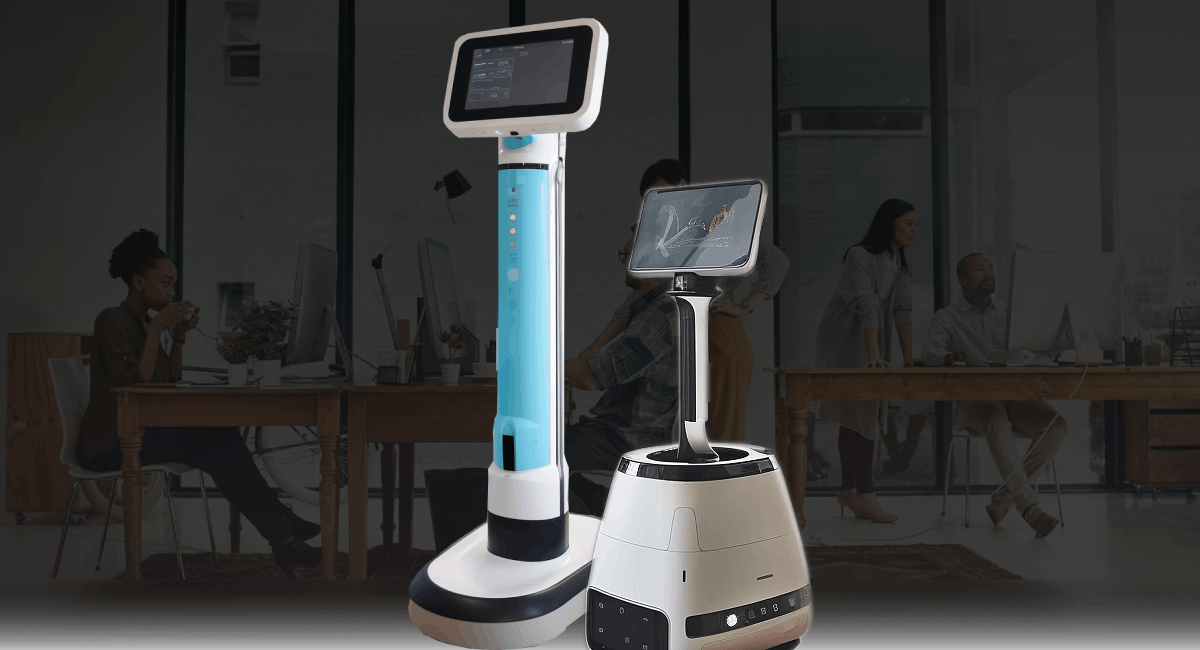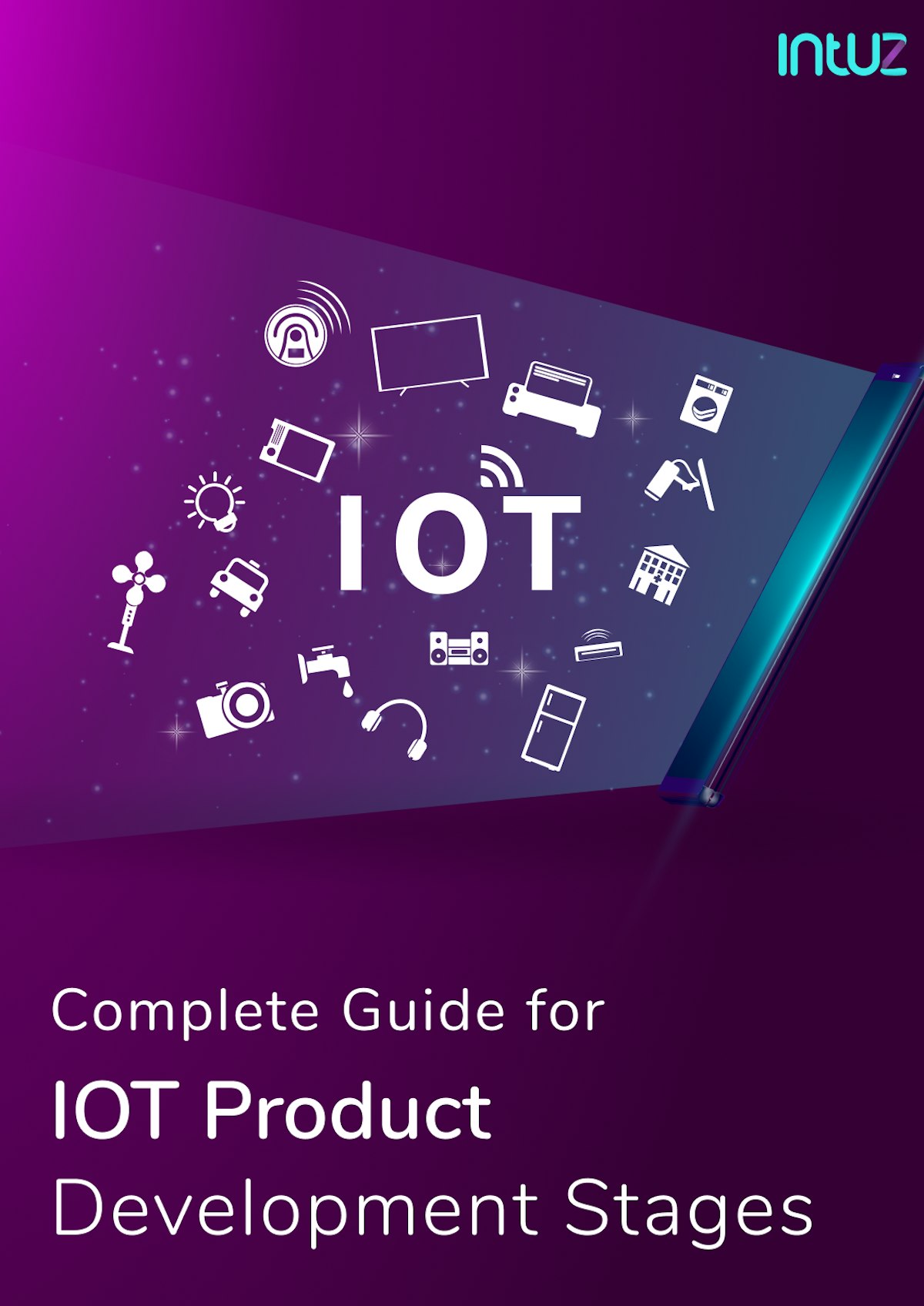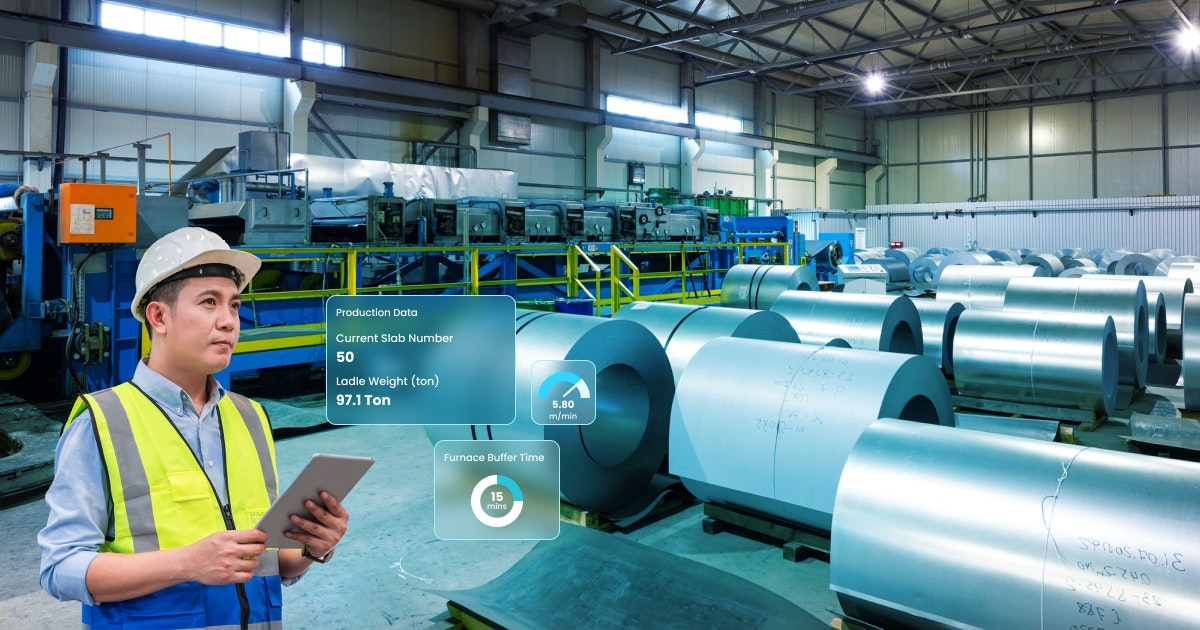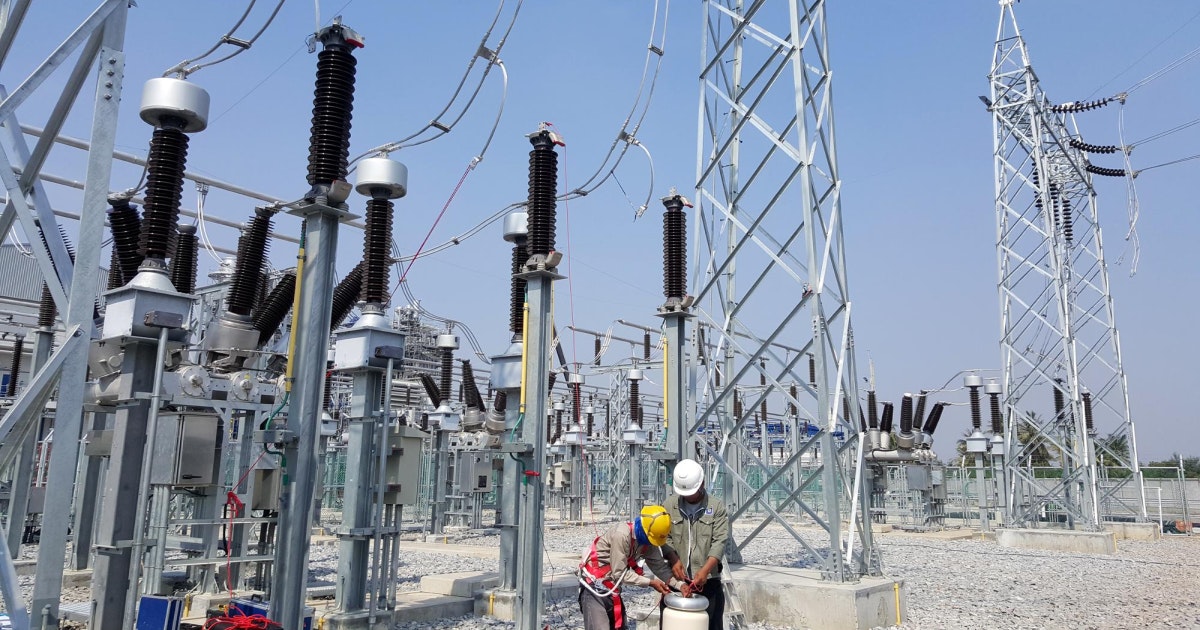Table of Content
What is IoT-Enabled Telepresence Robot
A telepresence robot, equipped with wireless internet connectivity and typically utilizing a tablet for video and audio functions, can be remotely controlled and is often used in various settings such as tour guiding, night watching, factory inspection, and healthcare consulting.
These robots offer the experience of being present in a particular location, allowing for remote interaction just as an on-site instructor might do in a classroom setting. Popular examples of telepresence robots include:
- Double Robotics Double 3 features an iPad integrated with a wheeled base and is primarily designed to enhance telecommuting and teleconferencing in a corporate setting.
- Ava from Ava Robotics boasts intelligent, autonomous navigation capabilities for large offices, event spaces, and retail establishments with built-in security features to protect corporate IT infrastructure.
- Vecna’s VGo is designed to help healthcare providers offer lower-cost services and high-quality virtual care and has also been used to help homebound students attend school virtually.
While telepresence robot solutions can be expensive, they are often a more cost-effective solution than the travel expenses they may replace. Research shows the global telepresence robot market will reach $312.6 million by 2023, growing at a CAGR of 15.96% between 2018 and 2023.
This is driven by advancements in wireless technology, such as the rise of 5G networks and edge devices, which provide faster and more reliable connectivity. Additionally, improvements in robotics and AI have made telepresence robots more versatile, user-friendly, and smart.
Enhance Your Remote Presence with IoT-Powered Telepresence Robots!
Let's Get StartedApplications of IoT-Powered Telepresence Robots in Different Sectors
The Internet of Things (IoT) enables real-time data transmission and analysis, providing businesses with valuable insights for making informed decisions, smoothing their operations, and boosting the bottom line.
IoT enables the remote monitoring and control of telepresence robots, allowing users to access and control the robots anywhere with an internet connection. Furthermore, it provides enhanced security features, such as real-time video monitoring and data encryption, ensuring user safety and data privacy.
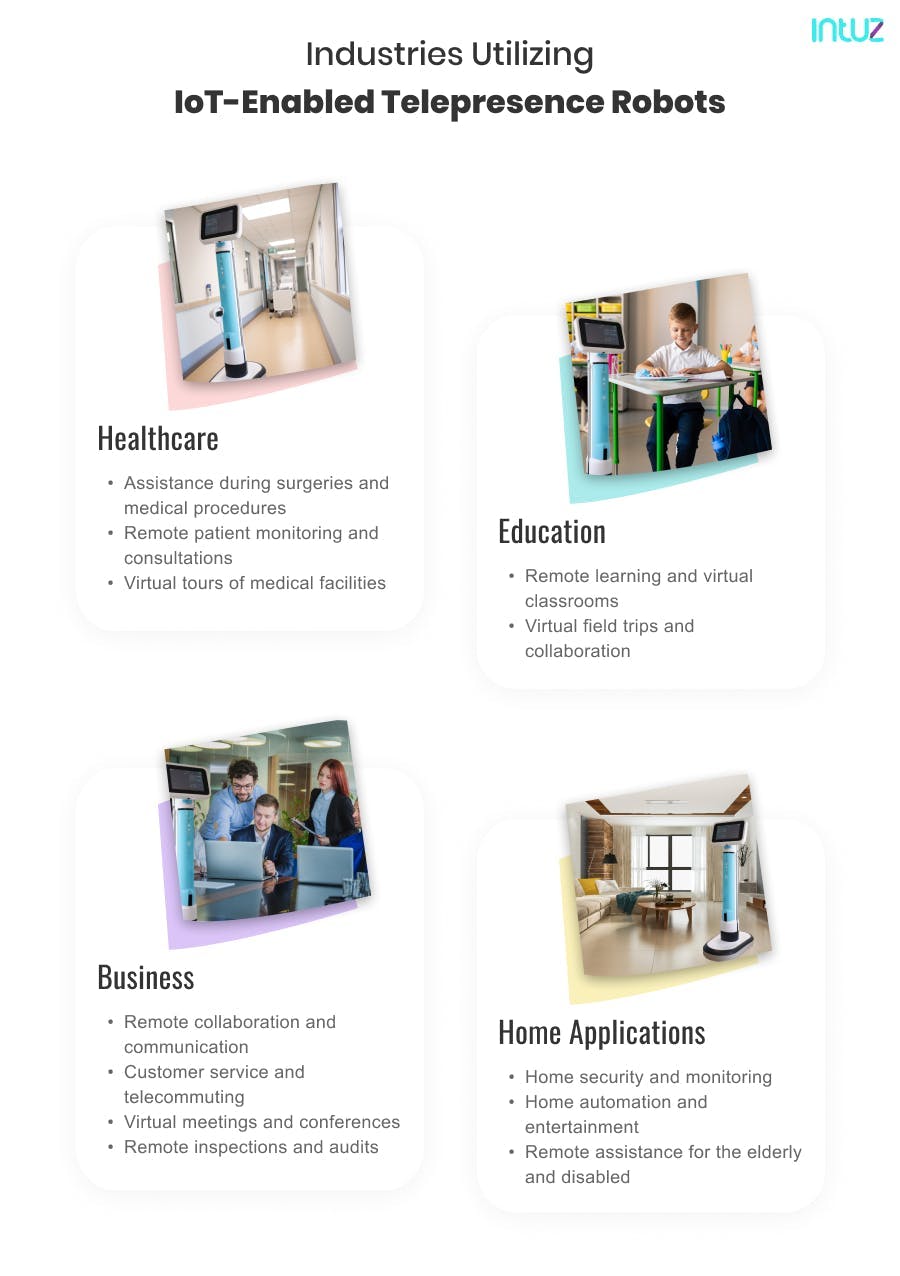
IoT-powered telepresence robots have proven helpful in various industries, from healthcare and education to manufacturing and retail. They are equipped with sensors, cameras, microphones, and speakers, allowing users to interact remotely with their environment and others in real time.
Integrating IoT into robotics helps build fully autonomous networks that can execute complex operations within the physical realm. By merging the capacity of robotic technologies to interact with the physical environment with the power of the IoT to establish smart and self-sufficient networks, we unlock immense potential for innovation and advancement.
Now, let us dive deep into how IoT-powered telepresence robots play a part in the following industries:
1. Healthcare
It is an essential aspect of modern society, and telepresence robots have disrupted healthcare delivery in ways one cannot even imagine!
a. Assistance during surgeries and medical procedures
One of the significant advantages of telepresence robots is their ability to provide remote visualization and communication capabilities during surgeries and medical procedures. Surgeons can access real-time data and images from remote locations, which ensures that surgeries happen with greater accuracy and safety. Telepresence robots also limit the number of people in the operating room, which reduces the risk of infection during such procedures.
b. Remote patient monitoring and consultations
This technology enables healthcare providers to deliver quality care to patients from remote locations. Patients with limited mobility or disability, who live in remote areas or need frequent monitoring, can benefit significantly. Additionally, telepresence robots lessen the burden on healthcare facilities by enabling patients to receive care remotely.
c. Virtual tours of medical facilities
These robots provide patients and visitors with virtual tours of medical facilities, which can help them explore the premises without physically visiting. This is useful for improving patient satisfaction and engagement by providing a more immersive experience. Furthermore, virtual tours can reduce infection risk by limiting the number of visitors to the medical facility.
2. Education
This technology has numerous benefits for both students and teachers.
a. Remote learning and virtual classrooms
Telepresence robots allow students to participate in classes remotely, making education accessible to everyone. Those unable to attend school due to illness or disability can benefit significantly from this technology. The teachers, on the other hand, can provide real-time feedback to remote students, making the teaching experience more interactive.
b. Virtual field trips and collaboration
These robots enable students to explore new places and work together on assignments beyond geographical boundaries. Virtual field trips eliminate the need for permission slips, travel costs, and other logistical arrangements. Telepresence robots allow students to interact with their environment, each other, and their teachers in real time.
Using IoT To Improve The Quality And Reliability Of Power Generators
Learn More3. Business
Telepresence robots have the potential to increase worker productivity, reduce travel costs, and improve customer satisfaction - for a good reason.
a. Remote collaboration and communication
Telepresence robots increase worker productivity and reduce travel costs. This technology allows employees to connect with their peers and managers from anywhere in the world, making it easier to work on projects that require collaboration across different time zones.
b. Customer service and telecommuting
Telepresence robots minimize the workload on customer support staff and improve response times to inquiries. They enable businesses to deliver a tailored and practical customer service experience while allowing employees to work from any location with internet access.
c. Virtual meetings and conferences
This technology pares down travel costs and increases productivity by eliminating employees’ need to travel to meetings. Telepresence robots can also help lessen the environmental impact of business travel.
d. Remote inspections and audits
With this technology, businesses can conduct inspections and audits more efficiently and cost-effectively, as inspectors can remotely access and analyze data from different locations and equipment pieces. This technology also brings down the need for on-site inspections, which can otherwise be time-consuming and expensive.
4. Home applications
Homeowners can leverage the benefits of telepresence robots to monitor their homes, control their home devices remotely, and receive remote assistance when needed.
a. Home security and monitoring
These robots give homeowners a sense of security and peace of mind, as they can undertake virtual home tours from anywhere with an internet connection and keep an eye on their property. Telepresence robots can be integrated with smart home security systems, providing real-time video monitoring and remote access to home devices.
b. Home automation and entertainment
Telepresence robots can be integrated with home automation systems to control various devices and provide entertainment to users, who can, in turn, control their home devices remotely and enjoy a more convenient and enjoyable home entertainment experience.
c. Remote assistance for the elderly and disabled
Telepresence robots provide remote assistance for elderly and disabled individuals, allowing them to communicate with healthcare providers and family members from remote locations. This technology enables them to receive medical assistance and support without physically visiting a healthcare facility.
The undeniable impact of IoT-powered telepresence robots
These robots use sensors, cameras, and other IoT devices to transmit real-time information to the operator, who can control the robot’s movements, actions, and interactions with its surroundings. Here are some of the advancements and developments in IoT-powered telepresence robots and their impact:
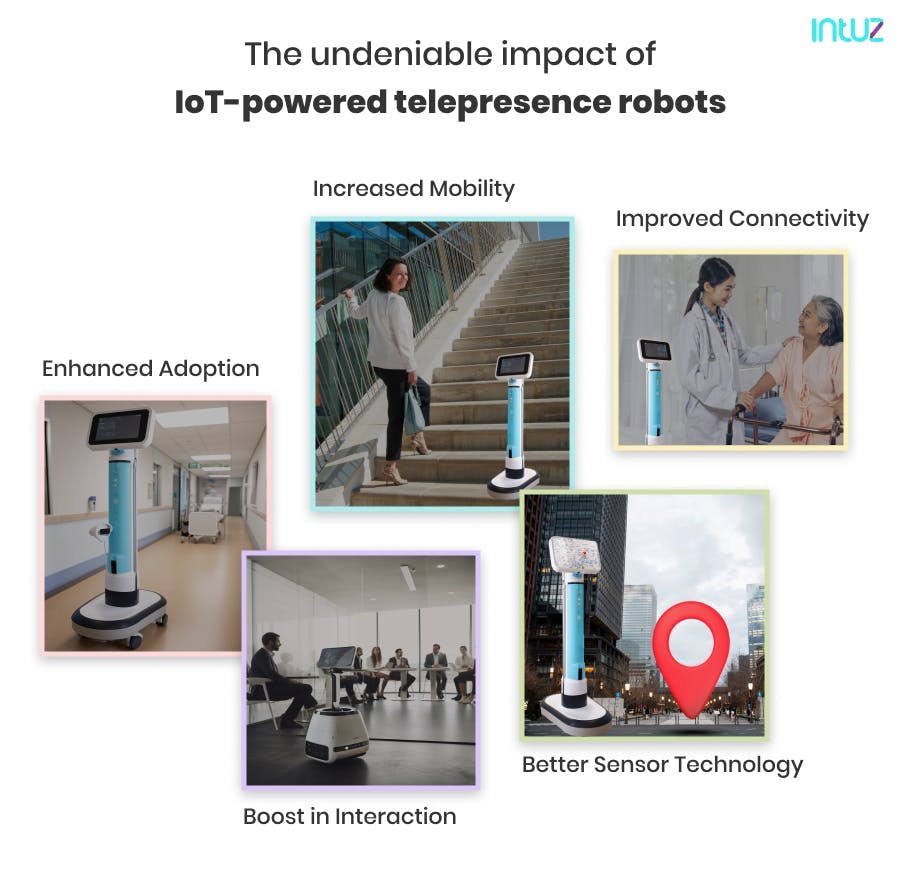
1. Enhanced adoption
The COVID-19 pandemic accelerated the adoption of telepresence robots, increasing remote work and virtual interactions. Telepresence robots are a valuable tool for businesses, schools, and healthcare facilities that need to maintain communication and collaboration despite physical distancing requirements.
For businesses, telepresence robots enable employees to work from home while still being able to interact with colleagues and customers in real-time. This technology also allows them to maintain their operations and productivity during crises or disruptions.
2. Increased mobility
Telepresence robots with advanced mobility features, such as climbing stairs and traversing uneven terrain, are valuable in various environments. For instance, hospitals can seamlessly transition between floors and maneuver around obstructions. In warehouses and factories, they can effortlessly navigate various workstations and zones, enhancing overall productivity and efficiency.
3. Boost in interaction
Telepresence robots incorporating advanced features like facial and gesture recognition can foster more natural interactions with individuals in remote locations. They can recognize the person they are communicating with, facilitating connection-building and trust formation.
Likewise, gesture recognition capabilities allow the robots to respond to gestures made by individuals in remote locations, which promotes seamless information exchange and effective collaboration.
4. Improved connectivity
The expanding availability of high-speed internet connections and 5G networks has facilitated the more efficient and seamless operation of telepresence robots.
With the reduced lag time and improved video and audio quality, users can enjoy a more immersive and engaging experience while interacting with telepresence robots. This enhanced connectivity enables telepresence robots to integrate seamlessly with other connected devices and systems, boosting their overall functionality and practicality.
5. Better sensor technology
The emergence of advanced IoT sensor technology, including depth, laser, and thermal sensors, has revolutionized how telepresence robots perceive and respond to their environment.
These sensors enable them to obtain more accurate and precise data and make better-informed decisions. For instance, depth sensors provide telepresence robots with accurate 3D maps of complex environments, enabling them to navigate efficiently.
Similarly, laser sensors help avoid obstacles and make safe decisions when moving around. Thermal sensors help detect and identify objects and people in low-visibility or low-light environments, such as warehouses or manufacturing plants.
Streamlining Logistics: How IoT Improves The Efficiency Of Perishable Goods Transportation
Learn MoreCommon challenges in the adoption of the telepresence robot
1. Initial cost
The technology is expensive to purchase, integrate, and maintain, which may limit its adoption by individuals for personal uses or small businesses.
2. Privacy concerns
Telepresence robots can potentially compromise privacy by capturing audio and video data that may be sensitive or confidential.
3. Social acceptance
The technology may not be widely accepted in certain settings, such as in-person meetings or social gatherings, where they may be viewed as impersonal or intrusive.
4. Technical challenges
The technology requires a reliable internet connection and can be susceptible to technical glitches or malfunctions, impacting its effectiveness.
5. Lack of human interaction
Telepresence robots can limit the ability for people to interact face-to-face, which can impact the quality of communication and collaboration in the long run and affect business operations.
Benefits of IoT Powered Telepresence Robots
Telepresence robots have the potential to revolutionize the way we work, learn, and interact with others. However, like any emerging technology, there are benefits and challenges associated with the widespread adoption of telepresence robots. Let us take a look:
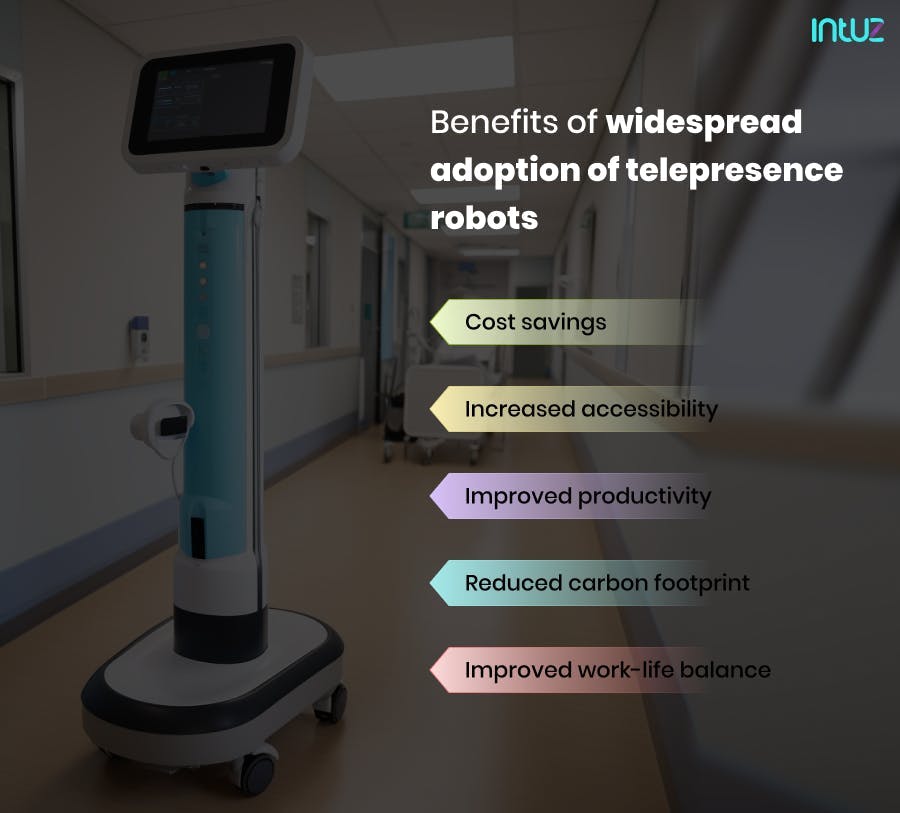
1. Cost savings
The technology eliminates the need for travel to attend meetings or events, reducing costs associated with travel and time spent commuting. This makes it a cost-effective solution for businesses and individuals needing to attend events or collaborate remotely.
2. Increased accessibility
These robots offer a means for people to participate in events and meetings remotely, regardless of location. This makes it possible for individuals with disabilities or those residing in remote areas to engage in social or professional activities that would otherwise be difficult to access.
3. Improved productivity
Telepresence robots increase productivity by enabling remote workers to participate in meetings, collaborate with colleagues, and access essential resources without being physically present.
4. Reduced carbon footprint
The technology minimizes the carbon footprint associated with travel by reducing the need for people to commute to meetings or events.
5. Improved work-life balance
Telepresence robots help people achieve a better work-life balance by enabling them to work remotely while still being able to participate in important meetings and events.
Are You Ready to Integrate IoT-Powered Telepresence Robots?
Let's Get StartedConclusion
Several factors must be considered to successfully implement telepresence robots in business operations, such as technical requirements, cost, and privacy concerns. It is crucial to ensure a reliable internet connection and choose a suitable telepresence robot model.
Working with a trusted partner who can provide technical expertise and support throughout the implementation process is crucial. Thankfully, you can count on us.
Intuz offers IoT services and Bluetooth-enabled telepresence robot solutions to aid in successfully integrating this technology.
Book a Free 45-minute Consultation with Our IoT Experts Today! Get a customized roadmap and strategies to leverage IoT-enabled telepresence robots.
